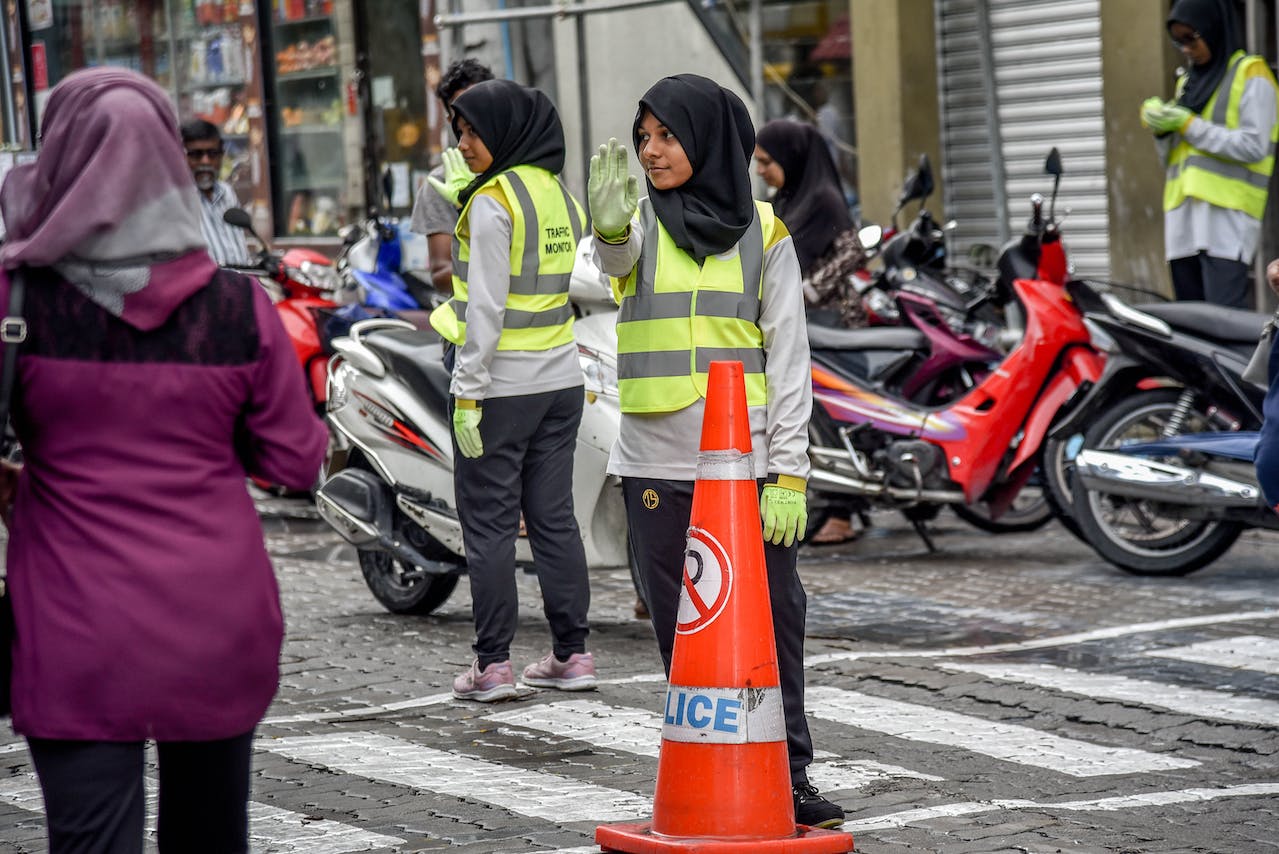Providing manual positive traffic control on the incident scene helps keep vehicles moving past the site and reduces rubbernecking. This approach can also save lives by allowing EMS units to respond more quickly.
Some on-scene traffic control devices are set up with a temporary duration; others have a longer duration intended. All of them must be responsive to the impact on traffic flow.
Traffic Control Devices
Traffic control devices, ranging from signs to signals to road markings, play an essential role in providing roadway users with clear directions and information. These vital tools are designed to effectively regulate traffic flow by establishing the rules that guide driver behavior and determining right-of-way assignment. They also efficiently communicate crucial details such as lane usage, intersections and turns, while mitigating the risk of accidents from erratic driving behaviors.
These critical communication tools work in tandem with the basic “rules of the road” contained in state and federal laws and regulations, including each jurisdiction’s uniform code that regulates vehicle movements. By determining the order of operations in traffic situations and conveying important messages to drivers, these devices significantly reduce disagreements between motorists about what should be done to safely navigate a given road situation.
While there are dozens of types of traffic control devices, they all follow a general set of design requirements laid out by the Manual on Uniform Traffic Control Devices (MUTCD). The MUTCD has a strong human-centered foundation and focuses on accommodating the expectancies and behavior of different road users with the aim of promoting safe, efficient mobility.
Signs provide the first visual cue to motorists of a potential emergency traffic scene, while directional indicators and signals ensure vehicles are on the correct path. The MUTCD recommends signs have a uniform shape, design and color to ensure they are easily recognized and understood by motorists. Signals are important safety devices that regulate traffic flows by assigning green, yellow and red indications to the direction of travel. These lights are designed to be visible at a distance and provide adequate time for motorists to react accordingly.
Other types of signage include variable-message signs, known as VMS, and highway advisory radio (HAR) displays that broadcast varying traffic messages on the highway. These signs can display a wide range of information, from work zone alerts to warnings about a hazardous condition. VMS and HAR can be either permanently mounted on structures such as bridges or overhead, or portable systems that are transported in trucks or trailers to respond to traffic problems.
Advance Warning
Early warning systems are designed to communicate information to motorists in an attempt to prevent traffic incidents by capturing and focusing their attention. These alerts could be related to road closures, work zone conditions or other roadway hazards that require a driver to change their action, for example changing lanes or preparing for railroad crossings. This information is relayed to motorists using advanced warning signs, flares or an emergency vehicle with its scene lighting activated. An effective integrated warning system requires data integration, customized alert templates, testing and training. Regardless of the method used, integrating communication structures with advance warning systems is a key component to minimizing traffic incident response times and ultimately saving lives.
ERSI recommends that an agency minimize the use of multiple early warning signs mounted on fire apparatus, ambulances, police vehicles or tow trucks and only utilize these when channelization is established at the scene. Excessive lighting can cause distraction and confusion for drivers, especially on divided facilities. Additionally, drivers are often distracted by flashing lights from the emergency vehicles they pass on their way to or from an incident scene. This can lead to them slowing down abruptly or stopping on the side of the highway to look at the traffic incident, which impedes flow and increases the likelihood of secondary crashes.
When working an incident, if the scene is located on or near a travel lane, it is best practice to place advance warning signs well in advance of the queue of stopped traffic. This ensures that high-speed traffic, which does not expect to encounter a stopped queue, is warned of the situation before they arrive at the queue area and have time to react appropriately. Coordinate with other units to coordinate the placement of these signs if you are the initial responding unit and additional units are not available.
The location of these signs should also take into consideration the distance from the scene to the prevailing speed limit. The actual distance may vary due to site specific conditions, however, the posted distances in MUTCD and WZTCM should serve as a guideline for starting points. In addition, sign locations should be positioned to be visible to drivers and not blocked by roadway features or other signs and traffic control devices.

Lane Opening
Full, partial, and shoulder closures are temporary traffic control measures that redirect or restrict travel lanes based on construction, maintenance, and emergency situations. These measures are designed to ensure the safety of road workers and minimize disruptions to roadway operations. In addition to lane closures, transportation authorities also employ a variety of other measures to effectively manage traffic flow and ensure the smooth operation of roadways during these events.
Whether you’re working at an incident scene or en route to one, properly positioning your vehicle can play a critical role in the effectiveness of emergency temporary traffic control. This is especially true when your lane closure taper requires a parked position in the active travel lane. In these situations, it’s important to utilize an S/SP vehicle equipped with an arrow panel in Arrow mode to warn motorists that the lane is closed.
The arrow panel is the most effective and efficient way to indicate that the travel lane is blocked at an incident site. Ideally, it should be placed upstream of the active incident. This allows crews to operate with maximum visibility and prevents drivers from inadvertently entering the active work zone. It also provides a positive visual indicator for motorists to stay clear of the area and allows emergency responders to quickly and easily communicate the status of the incident.
Shoulder closures are a common feature of most construction and maintenance projects, providing safe workspace for road crews and reducing the risk of traffic incidents in the roadway work zones. Shoulder closures may be permanent or a temporary lane shift that uses barricades and signage to create an alternative travel lane for vehicles. Static part-time shoulders can also be utilized when slower trucks need to climb a steep grade and are not safely passable in the regular travel lane.
According to the Keloka Traffic Management practice, when it comes to managing traffic during a special event, effective communication and proper use of traffic control devices are essential to maintaining normal traffic flow while keeping pedestrians and spectators safe. By using detour routes, directing traffic, and communicating changes in road conditions to drivers, temporary traffic management can help avoid delays and congestion while ensuring that roads are adequately equipped to handle the increased volume of traffic.
Demobilization
When a highway incident is fully resolved and the site is ready for the return of traffic, it is important to demobilize on-scene response resources in a controlled manner. The process of reducing the number of personnel and vehicles on scene allows for improved safety and efficiency while also eliminating duplication of efforts. During the demobilization phase, it is critical to communicate with facility managers, critical decision makers, and the public about what to expect. Demobilization guidelines provide agreed-to procedures to help improve coordination and facilitate expedited recovery.
The Incident Command System, or ICS, provides an organizational structure for managing emergency response resources during incidents. It is commonly used by fire departments but can also be applied to highway incident management. Using a standardized approach to managing response resources reduces confusion about who is in charge, enhances resource coordination and communications, and fosters a greater level of interagency cooperation.
A Demobilization Branch is an organizational element within the ICS that manages the transition from incident control to demobilization. The IC/UC or Operations Section Chief may establish one or more Demobilization branches depending on the size and complexity of the incident. Typically, these are grouped according to function (e.g., Traffic Management, Towing & Recovery, Communication, etc.), but they may be grouped by geographic location as well.
Demobilization is a complex task, and a good plan must be in place to ensure the safe return of traffic on an affected roadway. This includes a thorough review of the traffic control measures implemented, the need to address any ongoing safety issues, and the need to comply with local, State, and Federal transportation requirements, such as vehicle and driver licensing and rest periods. It is also necessary to address contractual obligations and resolve any remaining financial aspects of the project. Finally, a final inspection of the completed work is required to ensure that the finished product meets project specifications and industry standards. This will allow the Demobilization Branch to identify and report lessons learned and opportunities for future improvement. Additionally, it is a great opportunity to thank the dedicated servicemen and women of Reserve-component units who have spent much time away from their families and careers to support this effort.





